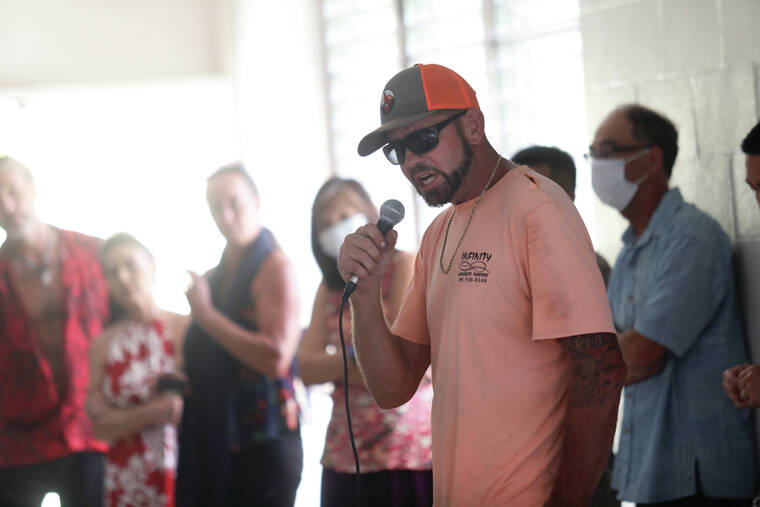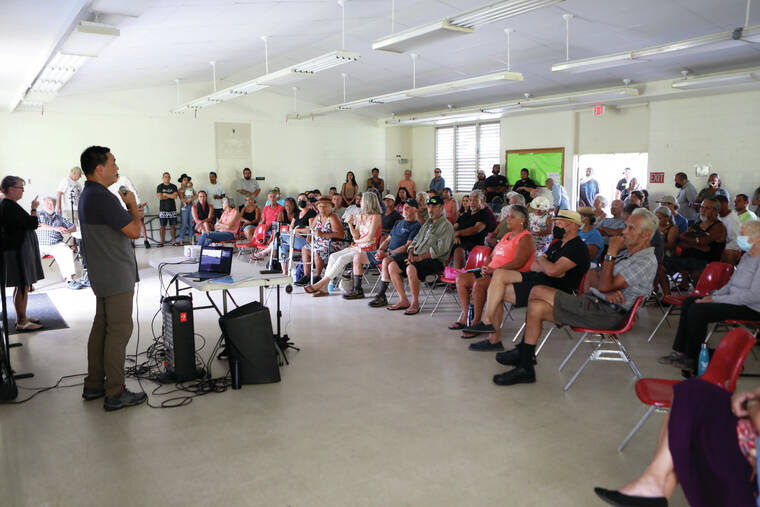Puna boat ramp blues: Four years after Kilauea eruption, community mulls three options

Kelsey Walling/Tribune-Herald Mark Love asks John Katahira why the state rejected a dredging plan brought up by Puna residents during a meeting Thursday about the eventual reopening of the Pohoiki Boat Ramp.

Kelsey Walling/Tribune-Herald Dozens of Puna residents gather Thursday at the Pahoa Community Center for a public meeting about a pre-design report for an eventual reopening of the Pohoiki Boat Ramp.
Two hours of spirited debate were not quite enough to come to a firm solution for what to do with the Pohoiki Boat Ramp.
Two hours of spirited debate were not quite enough to come to a firm solution for what to do with the Pohoiki Boat Ramp.
Dozens of Puna residents, many of them fishermen, gathered at Pahoa Community Center on Thursday for a public meeting about a predesign report for an eventual reopening of the ramp, which was cut off from the ocean in 2018 by a sandbar raised by lava entering the ocean during the Kilauea eruption that year.
ADVERTISING
John Katahira, principal engineer at Limtiaco Consulting Group, the Honolulu firm developing the reopening plan for the ramp, said the predesign report the group is preparing for the state was put “on pause” in order to consult the community about three potential options, none of which, he said, had a clear advantage over the others.
“We have a report that tells us one thing, what we can do and what we shouldn’t do,” said Department of Land and Natural Resources Deputy Director Bob Masuda. “We generally like to pay attention to these reports and follow them, but we also know there’s a time issue and a great burden on those who do fish.”
The three options Katahira presented offered three possibilities for how the sandbar in front of the boat ramp can be circumvented. Two of those options are variants of a single idea, involving a relatively simple channel dredged through the sand to allow boat access.
Those two options range between $3.6 million and $5.2 million and could begin construction as early as next year, Katahira said, but they have a potentially fatal flaw. Marc Ericksen, vice president of Sea Engineering Inc., said the channels would be “unstable” and could be quickly filled back in by sediment.
Ericksen said the wave action that affects Pohoiki has delineated how the harbor “wants” to be shaped. Even if the shape of the sandbar is altered by removing sediment, he said the ocean’s currents will deposit new sediment that will return the harbor’s contours to the same state, possibly within mere weeks.
The third option could circumvent that flaw. That option would also dredge a channel through the sandbar, but would build a pair of dikes flanking the channel, protecting it from the ocean’s currents.
However, that third option has its own potential problems: It could cost up to $62 million and would take years to complete.
Therein, Katahira said, lies the dilemma: a cheap and quick reopening with an unstable channel that could fill back in, or a stable channel that takes another several years to build and costs tens of millions of dollars more.
This conclusion was not popular among audience members. Many attendees questioned the engineering behind the plans, with some suggesting that the dredged channels would not be refilled by sediment, or that they could be stabilized without building dikes.
Katahira acknowledged that Limtiaco had considered at one point stabilizing the dredged channels using “marine mattresses” — essentially rocks wrapped in mesh that would line the bottom of the channel — but realized that, even if those were sufficient to stabilize the channel, they would exceed the terms of their permit with the state.
This admission led to anger from the audience, with several members shouting, “We don’t need the permit!”
Attendees also were upset by the revelation that no construction could begin until summer 2023 at the earliest. Katahira said an environmental assessment will be necessary for all of the options, and additional state funding won’t be available until next July.
Pervasive throughout the meeting was the audience’s frustration that the ramp has been out of commission for four years already, forcing fishermen to launch their boats from Hilo. Some attendees said the trips cost over $700 in gas alone.
“If I didn’t have to do the permit, I wouldn’t,” Katahira said. “If I didn’t have to do the permit, I wouldn’t. I’m actually trying to find ways to avoid doing it, not because I’m haphazardly trying to damage the environment, I know the urgency. But the fact is, we have to do permits because they’re required for funding.”
Katahira added that there are not yet any funds for the project allocated from the Federal Emergency Management Agency because FEMA requires an actual finished plan and a completed environmental assessment to allocate funds. Therefore, getting additional funds for the project will push the completion date still further out.
After a heated discussion, Katahira and Masuda said they hadn’t come out of the meeting with a clear sign from the Puna community which option is preferred. But one attendee, Ku‘ulei Kealoha Cooper, proffered a solution that most attendees seemed to agree with.
“Recommendation: Do option number one, a test dredge … and then follow up with the permanent solution with FEMA which is going to take millions,” Cooper said. “We will at least have our fishermen back in the water, and we will be assured the FEMA funds given Sea Engineering’s reports. So, let’s do both.”
Cooper’s suggestion raised a vigorous “eo” from the crowd.
Email Michael Brestovansky at mbrestovansky@hawaiitribune-herald.com.


